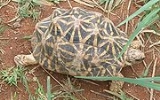
Indian Star Tortoise
Overview
The Indian star tortoise (Geochelone elegans) is a species
of tortoise
found in dry areas and scrub forest in India
and Sri Lanka
. This species is quite popular in the exotic pet
trade.
Carapace
very convex, dorsal shields often forming humps; lateral margins nearly vertical; posterior margin somewhat expanded and strongly serrated; no nuchal; supracaudal undivided, incurved in the male; shields strongly striated concentrically; first vertebral longer than broad, the others broader than long, third at least as broad as the corresponding costal.
Species
In biology, a species is one of the basic units of biological classification and a taxonomic rank. A species is often defined as a group of organisms capable of interbreeding and producing fertile offspring. While in many cases this definition is adequate, more precise or differing measures are...
of tortoise
Tortoise
Tortoises are a family of land-dwelling reptiles of the order of turtles . Like their marine cousins, the sea turtles, tortoises are shielded from predators by a shell. The top part of the shell is the carapace, the underside is the plastron, and the two are connected by the bridge. The tortoise...
found in dry areas and scrub forest in India
India
India , officially the Republic of India , is a country in South Asia. It is the seventh-largest country by geographical area, the second-most populous country with over 1.2 billion people, and the most populous democracy in the world...
and Sri Lanka
Sri Lanka
Sri Lanka, officially the Democratic Socialist Republic of Sri Lanka is a country off the southern coast of the Indian subcontinent. Known until 1972 as Ceylon , Sri Lanka is an island surrounded by the Indian Ocean, the Gulf of Mannar and the Palk Strait, and lies in the vicinity of India and the...
. This species is quite popular in the exotic pet
Exotic pet
An exotic pet is a rare or unusual animal pet, or an animal kept as a pet which is not commonly thought of as a pet.The definition is an evolving one; some rodents, reptiles, and amphibians have become firmly enough established in the world of animal fancy to no longer be considered exotic...
trade.
Carapace
Carapace
A carapace is a dorsal section of the exoskeleton or shell in a number of animal groups, including arthropods such as crustaceans and arachnids, as well as vertebrates such as turtles and tortoises. In turtles and tortoises, the underside is called the plastron.-Crustaceans:In crustaceans, the...
very convex, dorsal shields often forming humps; lateral margins nearly vertical; posterior margin somewhat expanded and strongly serrated; no nuchal; supracaudal undivided, incurved in the male; shields strongly striated concentrically; first vertebral longer than broad, the others broader than long, third at least as broad as the corresponding costal.
Unanswered Questions

